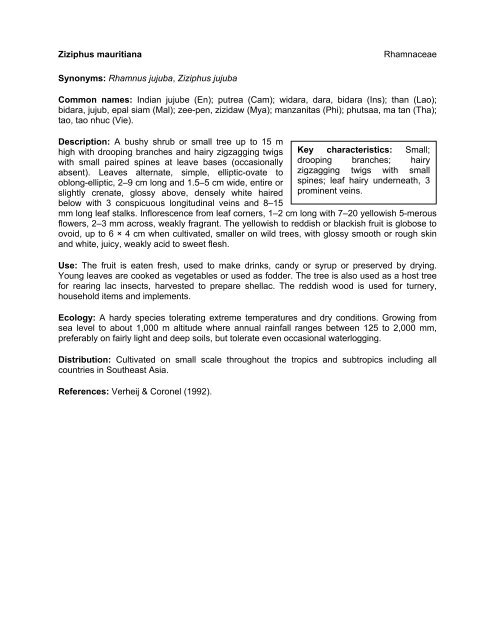TREES COMMONLY CULTIVATED IN SOUTHEAST ASIA
TREES COMMONLY CULTIVATED IN SOUTHEAST ASIA
TREES COMMONLY CULTIVATED IN SOUTHEAST ASIA
You also want an ePaper? Increase the reach of your titles
YUMPU automatically turns print PDFs into web optimized ePapers that Google loves.
Ziziphus mauritiana Rhamnaceae<br />
Synonyms: Rhamnus jujuba, Ziziphus jujuba<br />
Common names: Indian jujube (En); putrea (Cam); widara, dara, bidara (Ins); than (Lao);<br />
bidara, jujub, epal siam (Mal); zee-pen, zizidaw (Mya); manzanitas (Phi); phutsaa, ma tan (Tha);<br />
tao, tao nhuc (Vie).<br />
Description: A bushy shrub or small tree up to 15 m<br />
high with drooping branches and hairy zigzagging twigs<br />
with small paired spines at leave bases (occasionally<br />
absent). Leaves alternate, simple, elliptic-ovate to<br />
oblong-elliptic, 2–9 cm long and 1.5–5 cm wide, entire or<br />
slightly crenate, glossy above, densely white haired<br />
below with 3 conspicuous longitudinal veins and 8–15<br />
Key characteristics: Small;<br />
drooping branches; hairy<br />
zigzagging twigs with small<br />
spines; leaf hairy underneath, 3<br />
prominent veins.<br />
mm long leaf stalks. Inflorescence from leaf corners, 1–2 cm long with 7–20 yellowish 5-merous<br />
flowers, 2–3 mm across, weakly fragrant. The yellowish to reddish or blackish fruit is globose to<br />
ovoid, up to 6 × 4 cm when cultivated, smaller on wild trees, with glossy smooth or rough skin<br />
and white, juicy, weakly acid to sweet flesh.<br />
Use: The fruit is eaten fresh, used to make drinks, candy or syrup or preserved by drying.<br />
Young leaves are cooked as vegetables or used as fodder. The tree is also used as a host tree<br />
for rearing lac insects, harvested to prepare shellac. The reddish wood is used for turnery,<br />
household items and implements.<br />
Ecology: A hardy species tolerating extreme temperatures and dry conditions. Growing from<br />
sea level to about 1,000 m altitude where annual rainfall ranges between 125 to 2,000 mm,<br />
preferably on fairly light and deep soils, but tolerate even occasional waterlogging.<br />
Distribution: Cultivated on small scale throughout the tropics and subtropics including all<br />
countries in Southeast Asia.<br />
References: Verheij & Coronel (1992).
















